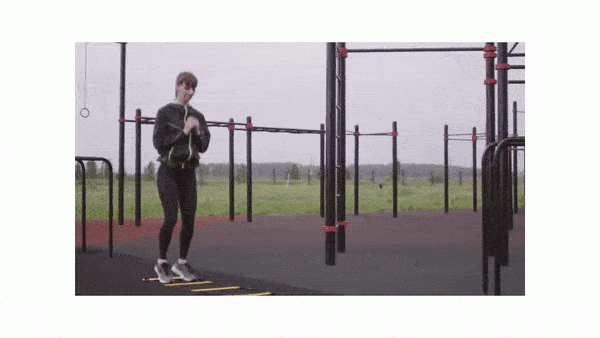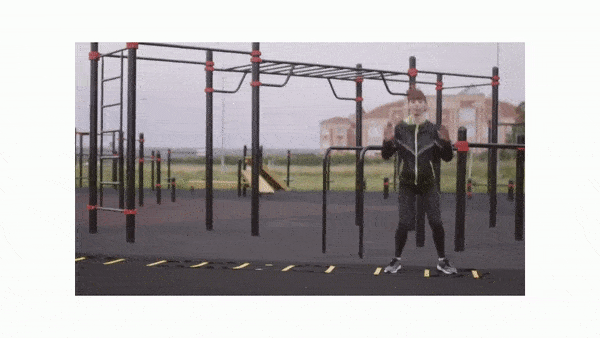Physical agility – the ability to move well at speed while maintaining proper form – is essential to good sports performance.
That’s why many athletes include agility training as part of their fitness routines.
At its core, agility training requires little more than one’s own body.
If you’ve got some space to move around and can create patterns, you have the ability to run agility drills to improve your speed and coordination.
But it does help to have some equipment to mark positions and aid in your training sessions.
If you’re just getting started with agility training, and it’s time to gear up, these are the pieces we recommend trying out first.
This page contains some affiliate links. If you click through and make a purchase, I’ll earn a commission, at no additional cost to you. Read my full disclosure here.
1. Agility Ladder
An agility ladder is exactly what it sounds like.
It’s basically a flat ladder that lays horizontally on the ground instead of diagonally up a wall.
When laid out, you have “side rails” on both sides and “rungs” that reach across to attach the rails together.
Between those “rungs” you have open spaces, which are the areas generally used during exercises.
Agility drills performed with a ladder start out very simple, but can become extremely complex.
You can go from this –
Basically, it’s a super simple piece of equipment that can guide you through a lot of movements.
Why we like it: While an agility ladder does lend to an infinite combination of drills, it’s also self-contained, which makes it easy for beginners to work with. (You don’t have to worry about setting up your own course.)
A good agility ladder also comes with a list of recommended exercises and patterns, so it’s easy to get started right out of the box.
Some ladders we like:
2. Medicine Ball
A medicine ball is a large weighted ball commonly used for strength training, but that can greatly enhance agility work.
Not only does a medicine ball add weight to any agility exercises you might do, but throwing a medicine ball requires power.
Thrusting a ball away at speed is an explosive motion that can train the arms, shoulders and back to put a lot of ‘oomph’ behind a sudden movement.
This can be beneficial to boxers, basketball players, or anyone who uses quick arm movements in their daily lives, whether they are construction workers or drummers.
Why we like it: Much like a ladder, medicine ball exercises start out simple. They often involve bouncing the ball off a wall and catching it in a variety of ways.
A medicine ball can also be added to other agility exercises to increase their level of difficulty and bring the upper body more into play.
Some medicine balls we like:
3. Reaction Ball (Agility Ball)
A reaction ball is a strange little ball with bumps covering its surface.
When thrown against a wall or bounced off the ground, the bumps on a reaction ball change its trajectory, making it impossible to know where the ball will go next.
In agility training, a reaction ball allows for some of the most freeform exercises.
There are no pre-planned patterns or drills. Instead, you go where the ball takes you.
This free-flowing style makes reaction ball training some of the truest training for both sports and the real world.
It’s about learning to react when things go unexpectedly.
Why we like it: It’s simple. Bounce (or roll) and chase. That’s all you have to do.
And it’s amazing for improving reflexes.
Some reaction balls we like:
4. Agility Cones, Dots, or Domes
Agility cones (dots or domes) are small markers that can be set up in a variety of ways.
This makes agility cones incredibly versatile and adds space for additional movement, such as sprints or shuffles.
The only issue with agility cones for beginners is that they can be a bit overwhelming.
Like agility ladders, they often come with some suggestions for layouts and drills you can do, but there’s still the matter of setting things up right.
As far as variety, though, cones are hard to beat.
Why we like it: So much versatility in such a simple package.
Some agility cones, dots and domes we like:
5. Agility Hurdles/Speed Hurdles
Agility hurdles, or speed hurdles, are miniature versions of the hurdles you’ve seen on any running track.
Like cones, they come in separate pieces which can be placed anywhere, but are designed to be gone over instead of around.
Speed hurdles come in a variety of sizes, but are typically between 6 and 12 inches in height. (There are also adjustable hurdles to make it a cinch to increase difficulty as your skills improve.)
Why we like it: Like cones, hurdles offer incredible versatility in a simple package.
They also add height to your agility training, which is essential for adding power to your jump.
Some speed hurdles we like:
Other Agility Sports Equipment You Might Consider
While the pieces above are our favorite pieces of agility sports equipment (especially for beginners), they are not the only pieces.
Other agility equipment you might want to consider include:
Agility Rings
Like cones in that they are individual pieces, but flatter and designed to step in and out of (more like an agility ladder).
Some rings can be locked together to create an even more ladder-like set-up.
Agility Box
A sturdy box used for agility jumping exercises. The rectangular shape allows it to be set up at differing heights.
- Rogue Foam Games Box
- Rogue Echo Foam Games Box (the cheaper, lighter weight version)
- BalanceFrom Foam Plyometric Box Heavy Duty
Agility Poles
Just like cones, but with a tall pole jutting up from the center that make them more visible. Poles can help with posture during agility training as well, serving as a guide that prevents leaning during exercises.
DIY Agility Equipment
If you really want to save on your agility equipment, or think many of these things sound so simple you could easily do them yourself, there’s also good old-fashioned simplicity.
Another piece of equipment you might want to keep on hand for your agility training is masking tape or field marking spray/turf paint.
With masking tape, you can “draw” your own ladder or mark spots on floors and hard surfaces.
With field paint, you can do the same on grass.
These things won’t replace agility balls, hurdles, or boxes, but they can do a lot of the basics ladders and cones can do.
Improve Agility
Agility is more than just a component of sports and fitness, it’s an essential part of everyday life, and, as such, everyone can benefit from adding a little agility work to their fitness routines.
If you’re ready to improve your agility but have no idea where to begin, check out Getting Started With Agility Training which will guide you through the basics.


